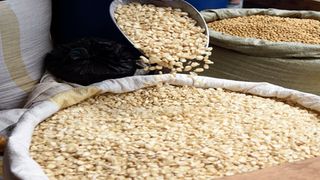
Ensuring proper standards across the value chain and seizing global trade opportunities will pave way for the country’s grain trade value chain in the region. PHOTO/MICHAEL KAKUMIRIZI
|Prosper
Prime
Why East Africa still needs Uganda’s grain
What you need to know:
While government is strengthening ties with the regional market to pave way for grain trade beyond the country’s borders, it must enforce standards to quell aflatoxins.
Uganda’s grain market is projected to expand despite fears relating to weather vagaries, use of archaic agricultural implements and low productivity concerns, Prosper Magazine can reveal.
Data from the Ministry of Trade, Industry and Cooperatives, under which the grain sector falls, show that formal and informal exports fetched a combined $2.9 billion in year 2016 which progressively increased to $3.45 billion in 2017 and $3.6 billion in 2018 respectively. Further growth continued in 2019, accruing $4.0 billion before peaking at $4.28 billion in 2020.
The combined contribution of particularly grain to informal and formal exports totals was $284.3 million in 2016 (nearly 10 per cent); rising in 2017 to $401.3 million (11.6 per cent) of the total; and to $436.8 million (12 per cent) in 2018.
However there was a decline in performance during 2019 to $275.4 million (6.7 per cent) before taking more hit – further declining to $243.2 million (5.7 per cent) in 2020, thanks to the Coronavirus epidemic.
Grains in formal and informal exports:
Before the decline in performance witnessed in 2020, the grains of relative significance in formal exports were beans and other legumes, according to sector prefect’s data.

Men offload bags of maize from a truck. Grain sector plays a crucial role in job creation, income generation, and the overall well-being of the population’s livelihood.. PHOTO/ Michael Kakumirizi
Maize and to a degree sorghum which each fetched returns of over $20 million per year (about Shs75billion), sesame seed along with maize and beans were the only grains to post significant exports earnings in 2019 and 2020.
In respect to informal exports beans and legumes were a consistent contributor until 2020. All in all, informal exports were affected more than formal exports by the coronavirus –induced decline in the economic activities.
But what could not be examined under this section due to lack of comparable data is to what extent informal trading affects formal trading in grains. What is obvious is that in the period 2016 to 2020 just about seven grains contributed nearly 90 per cent of total export earnings.
Checked out
Findings from a Market Research company - Mordor Intelligence, indicate that Uganda’s Grains Market size is expected to grow from $4.27 billion (about Shs16 trillion) in 2023 to $5.22 billion (nearly Shs20 trillion) by 2028.
Armed with the 2023-2027 National Grain Trade Policy Implementation Strategy, the government is working towards achieving much higher targets, should the quantity and quality of the traded grain and grain products be achieved as anticipated in the blueprint housed at Farmers House, Ministry of Trade.
During the Africa Grain Trade Summit held in Kampala last week, it emerged that the grain sector plays a crucial role in job creation, income generation, and the overall well-being of the population’s livelihood.
Additionally, like many other African countries, Uganda also faces numerous hurdles in maximising the potential of its grain industry. According to the Commissioner for MSMEs at the Ministry of Trade, Industry and Cooperatives, Dr Joshua Mutambi who represented the sector minister, Mr Francis Mwebesa, noted that challenges such as post-harvest losses, inadequate infrastructure and lack of access to finance remain significant obstacles.
More constrains
Since the adoption of the National Grain Trade Policy nearly 7 years ago, constraints of the sub sector haven’t substantially changed, largely due to lack of financial resources, inhibiting enforcement of the policy touted as a sector game-changer.
Limited agro-processing and value addition facilities, inadequate crop financing and lack of affordable credit, weak market linkages, limited enforcement of standards and potential for high infestation of grains with aflatoxins – all remain part of the grain trade fixture.
This has been worsened by the routine shortage and high cost of inputs, high level of post-harvest losses – estimated at between 20 to 40 per cent, and low levels of production and productivity.
“Government is implementing a range of policies and initiatives, including investment in modernising agricultural infrastructure, enhancing storage and processing facilities and promoting value addition to the grain products,” Dr Mutambi told the delegates attending the 10th African Grain trade Summit held last week at Munyonyo, Kampala.
In the Trade Minister’s speech, presented by Dr Mutambi, it was revealed that government is interested in attracting investors into storage facilities, production, input supply, value-added processing, standards compliance and export, and post-harvest handling.
Regionally and by extension throughout the continent, government is strengthening ties and cooperation to pave way for grain trade beyond the country’s borders, creating a seamless and efficient grain trade ecosystem that benefits all the players.
Data collection and dissemination, bolstering production of diverse grains, ensuring standards across the value chain and identifying and seizing global trade opportunities, according to Dr Mutambi is not only paramount, but will pave way for the country’s grain trade value chain in the region and beyond.
Opportunities
Grains grown in Uganda include maize, millet, sorghum, rice, and wheat. Grain industry players especially members of Grain Council of Uganda, also deal in sesame, green gram, soy beans and chia seeds. Grain in Uganda is normally grown by smallholder farmers. There are significant investment opportunities in the sector, including in production, input supply, value-added processing, standards compliance and export, and post-harvest handling. The market for the grains remains largely underserved, beginning in the national all the way to region and global markets.
Place for small and medium commercial farmers to thrive is wide open. Government priority to promote value addition and its priority on infrastructure development, all present investment in the sector possessing massive potential.

A man transports processed maize on a bicycle. There are significant investment opportunities in the grains sector. PHOTO/ MICHAEL KAKUMIRIZI
Part of the reason for the Grain Trade Summit whose theme: Defining Africa’s Place in Global Grain Trade for Sustainable Food Systems, according to the country director, Eastern Africa Grain Council (EAGC), Mr Emmanuel Asiimwe, is meant to increase grain production, improve quality of grains for both human consumption and animal feeds as well as ensure improved market access, to make the sector attractive to investment.
According to Mr Asiimwe who is an expert on post-harvest handling, noted aflatoxins can be controlled with proper drying.
He said: “How come our ancestors were never bedeviled with the aflatoxin problems?”
He continued: “What our ancestors did was to properly dry the grains. The granary were properly aerated and there were no aflatoxins. So proper post harvest handling is important in unlocking the fortunes of grain sector.”
Time and again, Uganda’s grains are barred from accessing regional market on the grounds of aflatoxin concerns. In March 2021, restrictions were imposed on maize importation by Kenya, citing aflatoxins and low-quality standards of maize. The ban has since been lifted.
Now Mr Assimwe is calling for a grain like authority akin to Coffee Development Authority or related body, charged with, among others, testing, certification and accreditation of industry players, saying that will stimulate market growth resulting from standard enforcement.
Surplus production
According to Mr Assimwe, only Uganda and Tanzania produce grain surplus in the region, underscoring the importance of the country in grain trade value chain. This is a clear manifestation of Uganda’s potential to feed the region.
According to the UN’s Food and Agriculture Organisation, Uganda’s fertile agricultural land has the potential to feed 200 million people. About 80 percent of Uganda’s land is arable, but only 35 percent is cultivated.




